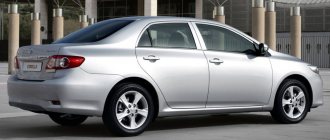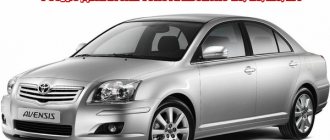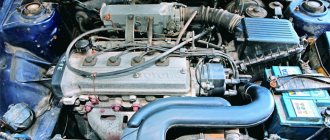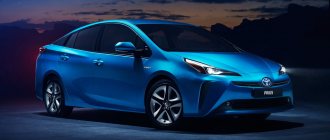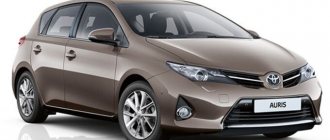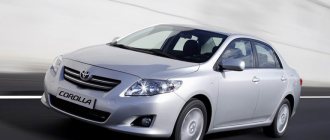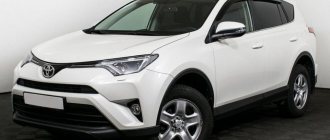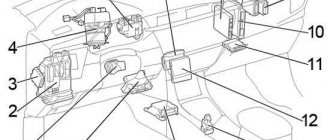Japanese automaker Toyota has been producing cars since 1933. Nowadays, cars of this brand have conquered the markets of Asia, Europe, Africa, North and South America. Engineers, designers, and marketers of the concern position the models created on production lines under the mottos “reliability” and “low cost of maintenance.”
Since the mid-70s of the last century, when fuel prices began to rise rapidly, power unit designers have focused on reducing the “appetite” of engines. At the moment, the fuel consumption of Toyota cars per 100 km is one of the lowest among cars in the whole world. You can verify this by analyzing the nominal fuel consumption of the most popular models indicated by the manufacturer and comparing them with the performance of cars from other brands.
Toyota Auris
This small model has been assembled on the production lines of the Japanese automaker since 2006 exclusively in the hatchback body. There are two modifications of the Toyota Auris: with three doors and five. In its class, the car competes with the Volkswagen Golf, KIA Sid and Peugeot 307, only in a few indicators being inferior to the products of the German automobile industry. The third generation of Toyota Auris is present on the domestic automotive market.
| Engine | Consumption (city) | Consumption (highway) | Flow (mixed) | Type of fuel |
| 1.3 MT 99 hp (Mechanics) | 6.7 | 4.7 | 5.4 | Petrol |
| 1.4 MT 90 hp (Mechanics) | 3.9 | 3.1 | 3.4 | Diesel |
| 1.4 AMT 90 hp (robot) | 5.8 | 4.4 | 4.9 | |
| 1.6 CVT 132 hp (variable speed drive) | 7.2 | 4.5 | 5.6 | Petrol |
| 1.6 MT 132 hp (Mechanics) | 7.9 | 4.8 | 5.8 | |
| 1.6 AT 132 hp (machine) | 9.1 | 5.8 | 7.0 | |
| 1.6 MT 109 hp (Mechanics) | 8.5 | 5.5 | 6.6 | |
| 1.6 AT 138 hp (machine) | 9.1 | 5.4 | 6.7 | |
| 1.8 CVT 134 hp (variable speed drive) | 3.6 | 3.5 | 3.6 | Hybrid |
| 2.0 MT 126 hp (Mechanics) | 5.4 | 4.0 | 4.5 | Diesel |
| 2.2. MT 177 hp (Mechanics) | 7.8 | 5.1 | 6.1 |
Official fuel consumption standards for Toyota Corolla
Corolla cars used 4-cylinder liquid-cooled engines equipped with a distributed fuel injection system. Cars with supercharged diesel engines were assembled to a limited extent.
The manufacturer determined efficiency based on tests at special test sites that allow simulating suburban or urban driving cycles. No model has claimed a parameter of more than 9 liters per 100 km in mixed mode.
Third generation E30
The cars were put on the assembly line in 1974 and are considered rare, not seen in everyday use. In the spring of 1976, the cars were modernized, which led to a change in the index to E50. The equipment was equipped with carburetor engines with a volume of 1.2 to 1.6 liters, which burned no more than 8 liters of unleaded gasoline in an average cycle. Cars were supplied to the Japanese domestic market and were exported to a limited extent.
Fourth E70
In the spring of 1979, Toyota introduced a new generation E70, which featured a larger body and increased comfort. In addition to carburetor power units, engines with a fuel injection system began to be offered, which were not very economical. Under the hoods were engines with power from 72 to 80 hp. With. (volume 1.3 and 1.5 liters, respectively), torque was transmitted to the rear wheels. Cars required no more than 8 liters of fuel in urban conditions, while on the highway the equipment required 6.4-7 liters per 100 km.
The fourth generation E70 was distinguished by increased comfort.
Fifth E80
In 1983, the Toyota concern mastered the production of the E80 generation, which received front-wheel drive. The cars were equipped with gasoline engines with a carburetor or injection system with a volume of 1.5 to 1.8 liters and developing up to 100 liters. With. A naturally-aspirated 65-horsepower diesel engine appeared in the production line, which could be operated with a manual or automatic transmission.
The fuel consumption of gasoline modifications in the combined cycle was in the range of 7-8.5 liters, the diesel unit burned about 5.6 liters of fuel in combined mode.
Sixth E90
The E90 generation has been produced by Toyota factories since 1987 and was actively supplied to foreign markets. The body had smoothed contours, which made it possible to reduce drag and reduce the owner’s fuel costs. The cars were equipped with naturally aspirated gasoline engines with a power of up to 105 hp. s., customers were offered a GT modification with a 140-horsepower unit. Diesels remain in the lineup. The cars consumed from 5 to 9 liters of fuel in the combined cycle; in city traffic, the parameter increased to 7-12 liters, which met current international requirements.
The sixth generation E90 has been produced since 1987.
Seventh E100
The E100 generation began to be assembled in the summer of 1991, the cars are often found on Russian roads. Cars in basic equipment were equipped with engines with a carburetor, but most of the equipment had engines with electronically controlled gasoline injection and emission reduction systems. The fuel consumption values declared by the plant in liters per 100 km for different engines are shown in the table.
| Motor type | On the road | In the city | Combined mode |
| 1.3 l, carburetor | 5,1 | 7,7 | 6,7 |
| 1.6 l, injection | 6,8 | 9,1 | 7,6 |
| 2.0 l, diesel | 5,8 | 7,8 | 6,4 |
Eighth E110
The Toyota concern launched the production of new generation E110 cars in the late spring of 1995; the body of the cars received streamlined shapes and varied depending on the sales market. Spark ignition engines were used, equipped with fuel injection and having a volume of 1.3 to 1.8 liters. There were also diesel modifications with 4-cylinder units 2C-III and 3C-E with a volume of 1.9 and 2.2 liters. Engines with a volume of up to 1.6 liters burned an average of about 7-7.5 liters of fuel, diesel engines required 6-6.5 liters of fuel.
At the end of spring 1995, Toyota launched production of E110 cars.
Since 1998, a 1.8-liter gasoline 1ZZ-FE appeared in the production range. The power unit was distinguished by the use of an aluminum block and head, which reduced the weight of the car. With a power of 125 hp. With. the engine burned 9.9 liters of fuel in the city.
But on the highway the engine required only 4.8 liters of fuel; in the combined cycle, consumption did not exceed 7.8 liters per 100 km.
Restyling 1999
The modernization carried out led to minor modifications to the interior and exterior of the body. The range of power plants has changed, on which the VVTi system (continuously variable valve timing) has appeared. Due to the modifications, it was possible to improve the performance of gasoline engines at low speeds. The fuel consumption values declared by the factory for different engine models are shown in the table.
| Volume, l | Power, l. With. | Type | On the road | In the city | Combined mode |
| 1,3 | 85 | petrol | 5,9 | 8,8 | 7,4 |
| 1,4 | 97 | petrol | 5,5 | 8,7 | 7,2 |
| 1,6 | 110 | petrol | 5,9 | 9,1 | 7,6 |
| 2,2 | 79 | diesel | 4,8 | 7,2 | 6,0 |
Toyota Corolla E120
Cars of the new generation Corolla E120 began to be delivered to customers from the end of the summer of 2000, the cars were officially supplied to the Russian market. The model turned out to be the most popular Corolla and was subsequently assembled under other designations in China. The cars were available in sedan, hatchback and station wagon body styles.
Toyota Corolla E120 cars began to be supplied in 2000.
It was planned to install gasoline engines operating with a manual or automatic transmission. Fuel consumption for different types of engines is shown in the table.
| Volume, l | Box | Power, l. With. | On the road | In the city | Combined mode |
| 1,4 | Manual transmission | 97 | 5,7 | 8,4 | 6,7 |
| 1,6 | Manual transmission | 110 | 5,9 | 9,0 | 7,0 |
| 1,6 | Automatic transmission | 110 | 6,4 | 10,6 | 7,9 |
Restyling 2004
The modernization affected the design of the body and interior; the chassis and power units did not undergo changes. In some markets, a modification with a 136-horsepower engine began to be offered; such models were not officially sold in Russia. The car had improved dynamics, but in city traffic the consumption declared by the factory was up to 11.4 liters per 100 km, and in winter in traffic jams it reaches 13 liters.
On the highway, the car fits 7.5-8.0 liters only when driving quietly at a speed of 90-100 km/h.
Toyota Corolla E140
In the fall of 2006, the Corolla E140 generation was introduced for the Japanese market, equipped with gasoline engines. 5-speed manual transmissions were offered (the gear ratio of the main pair depended on the engine size), and continuously variable transmissions were also installed, which made it possible to increase efficiency and reduce fuel consumption. Cars were imported to Russia to a limited extent through the Far Eastern regions.
Toyota Corolla E140 is a new generation for the Japanese market.
Average fuel consumption:
- the basic version with a 1.5-liter unit and a manual transmission burned about 8 liters; when installing a variator, the parameter dropped by 0.4-0.5 liters;
- the version with a 150-horsepower supercharged engine was equipped only with a manual gearbox and consumed up to 8.5 liters of fuel in the combined cycle;
- a modification with a 1.8-liter engine and a CVT required 9-9.5 liters of gasoline.
Eleventh generation E150
For foreign markets, since 2006, the Toyota concern has offered cars of the E150 generation, which had front-wheel drive and a 4-door sedan body. Base models had a manual transmission, with a 4-speed hydromechanical transmission available. For 1.5 years, the plant has been supplying cars with a robotic gearbox (a standard mechanical unit with clutch drives and electronically controlled switching electromagnets).
The table shows efficiency parameters for different types of engines.
| Volume, l | Box | Power, l. With. | On the road | In the city | Mixed mode |
| 1,3 | Manual transmission | 101 | 4,9 | 7,3 | 5,8 |
| 1,4 | Manual transmission | 97 | 5,7 | 8,6 | 6,7 |
| 1,6 | Manual transmission | 124 | 5,8 | 8,9 | 6,9 |
| 1,6 | Automatic transmission | 124 | 6,0 | 9,3 | 7,2 |
| 1,6 | robot | 124 | 5,7 | 8,4 | 6,7 |
Restyling 2015
In 2015, the E180 generation was modernized. The cars were offered with engines ranging from 1.3 to 1.8 liters. In addition to the 6-speed manual transmission, a CVT was installed. The table shows fuel consumption according to factory data.
| Volume, l | Box | Power, l. With. | On the road | In the city | Combined mode |
| 1,3 | Manual transmission | 99 | 4,7 | 7,2 | 5,6 |
| 1,6 | Manual transmission | 122 | 5,4 | 8,7 | 6,6 |
| 1,6 | variable speed drive | 122 | 5,3 | 8,2 | 6,3 |
| 1,8 | variable speed drive | 140 | 5,3 | 8,3 | 6,4 |
Toyota Hilux
This model, whose production began in 1984, is a classic off-road pickup truck. In demand among motorists all over the world. During its release, there were 8 generations of Hilux. It has been present in the domestic car market since the 3rd generation (1995). The pickup truck is available in three modifications: with a regular cab, double cab and extended cab. The car interior can comfortably accommodate 4-5 people.
| Engine | Consumption (city) | Consumption (highway) | Flow (mixed) | Type of fuel |
| 2.7 AT 163 hp (machine) | — | — | 11.0 | Petrol |
| 3.0 AT 170 hp (machine) | — | — | 8.8 | Diesel |
| 3.4 AT 185 hp (machine) | — | — | 11.6 | Petrol |
| 4.0 AT 249 hp (machine) | — | — | 13.3 |
Toyota Corolla 1.3, 1.4, 1.6, 1.8 fuel consumption per 100 km
Over the past few decades, Japanese automobile companies have accustomed almost all car enthusiasts to the idea that the most reliable and high-quality cars are produced in the “Land of the Rising Sun.” A clear confirmation of this is the Toyota Corolla, the number of sales of which to date has already exceeded 40 million units worldwide. The history of the Corolla began back in 1965.
During this time, the model has survived eleven generations and several restylings. An incredible success of a car that certainly deserves to be emulated. Even in times of crisis and fierce competition, this car continues to be in demand. Many people who want to buy a compact sedan are interested in the fuel consumption of the Toyota Corolla per 100 km. Next, based on owner reviews, we will find out the actual gas mileage of the car.
Toyota Venza
Toyota Venza appeared in 2009. The model, which perfectly combines the cross-country ability of an SUV, has enough free space (as in station wagons) and a comfortable interior of a luxury sedan. The production of Venz continues to this day, after minor cosmetic changes in 2012. Equipped with two types of engines and a six-speed automatic transmission. There is a choice of drive: either front-wheel drive or all-wheel drive.
| Engine | Consumption (city) | Consumption (highway) | Flow (mixed) | Type of fuel |
| 2.7 AT 185 hp (machine) | 13.2 | 8.0 | 9.8 | Petrol |
| 3.5 AT 268 hp (machine) | 13.1 | 9.4 | 10.8 |
Toyota Land Cruiser
The Land Cruiser is the longest-living car in the Toyota line. The first representative of this series left the factory gate back in 1960. Since then, more than a dozen generations have changed, but each new version (Land Cruiser 80, 100, 120, 150 and 200) has been successful in many countries around the world. The popularity of the car is associated with its good cross-country ability, powerful power units and high level of comfort. Toyota engineers made the latest changes to engine technical characteristics in 2015.
| Engine | Consumption (city) | Consumption (highway) | Flow (mixed) | Type of fuel |
| 4.0 AT 271 hp (machine) | 16.6 | 9.7 | 12.3 | Petrol |
| 4.5 AT 249 hp (machine) | 9.6 | 7.0 | 8.0 | Diesel |
| 4.6 AT 318 hp (machine) | 18.1 | 11.3 | 13.8 | Petrol |
| 5.7 AT 381 hp (machine) | 18.0 | 13.0 | 15.6 |
Toyota Avensis
Toyota Avensis appeared on the global automotive market in 1997, replacing the Karina E model. This is a class D car, which is produced in sedan and station wagon bodies and is intended primarily for European buyers. The high-quality assembly and comfort of the Toyota Avensis makes it similar to local manufacturers, and the price is slightly lower. Currently, third-generation units are leaving the Toyota factory assembly line.
| Engine | Consumption (city) | Consumption (highway) | Flow (mixed) | Type of fuel |
| 1.6 MT 112 hp (Mechanics) | 5.1 | 3.5 | 4.2 | Diesel |
| 1.8 MT 147 hp (Mechanics) | 8.0 | 4.9 | 5.9 | Petrol |
| 1.8 CVT 147 hp (variable speed drive) | 8.0 | 4.8 | 5.8 | |
| 2.0 MT 143 hp (Mechanics) | 5.7 | 3.7 | 4.6 | Diesel |
| 2.0 CVT 152 hp (variable speed drive) | 8.2 | 4.8 | 6.1 | Petrol |
| 2.4 AT 163 hp (machine) | 13.4 | 7.1 | 9.4 |
Toyota Highlander
The Highlander is a mid-size SUV option from the Japanese manufacturer. The first representatives of this model range left the factory in 2001. The car is popular with drivers from the USA, Australia and Japan. It is also present on Russian roads. The main consumers of such cars are young people. The Highlander went through two generation changes, during which its appearance changed slightly. Another feature of this model is the presence of two hybrids. The Toyota Highlander Hybrid is equipped with engines with a volume of 3.3 and 3.5 liters and a power of 212 and 245 horsepower.
| Engine | Consumption (city) | Consumption (highway) | Flow (mixed) | Type of fuel |
| 2.4 AT 157 hp (machine) | 10.6 | 8.6 | 9.8 | Petrol |
| 2.7 AT 189 hp (machine) | 11.8 | 9.7 | 10.6 | |
| 3.0 AT 223 hp (machine) | 12.2 | 9.7 | 10.9 | |
| 3.3 AT 232 hp (machine) | 12.5 | 9.3 | 11.4 | |
| 3.3 CVT 212 hp (variable speed drive) | 9.4 | 8.7 | 8.9 | Hybrid |
| 3.5 AT 273 hp (machine) | 12.8 | 7.7 | 9.5 | Petrol |
| 3.5 CVT 245 hp (variable speed drive) | 8.6 | 8.4 | 8.4 | Hybrid |
The influence of the installed air conditioner and the width of the car wheels
There is an opinion that air conditioners in cars do not in any way affect the overall fuel consumption. But, as it turns out from experience, this is absolutely not the case. If the air conditioner is turned on at full power during the hottest time, then fuel consumption begins to increase by approximately 10%. What is the reason for this? When the air conditioner turns on, there is additional load on the engine. And the more the engine is loaded, the more fuel it will consume.
If a car has wide wheels, then more aerodynamic drag is created than with narrow wheels. For this reason, fuel consumption increases. Therefore, it is better not to change the width. Let the one supplied by the manufacturer remain.
Regular maintenance will ensure that fuel consumption does not increase.
Toyota Prius
Toyota Prius is the first model in the world approved for mass production exclusively with a hybrid power plant. Car production began in 1997. Since then, it has collected many awards and accolades of all kinds and has been called “the car that changed the world.” The main technical characteristics of the Prius are low fuel consumption and environmental friendliness. These days, fourth-generation hybrid models called the Toyota Prius XW 30 are rolling off production lines.
| Engine | Consumption (city) | Consumption (highway) | Flow (mixed) | Type of fuel |
| 1.5 AT 72 hp (machine) | 5.0 | 4.1 | 4.6 | Hybrid |
| 1.8 AT 98 hp (machine) | 3.8 | 3.7 | 3.8 | |
| 1.8 CVT 98 hp (variable speed drive) | 3.0 | 2.8 | 3.0 |
Toyota Corolla
The first copies appeared back in 1966 and since then have been extremely popular all over the world. Toyota Corolla is recognized as the best-selling car (confirmation can be found in the Guinness Book of Records). During its release, it went through ten generations and went through many updates. The Corolla (model E120) appeared on the Russian automobile market with the ninth generation, which started in 2001. This generation is perhaps the most variable - cars were produced in station wagon, sedan, and hatchback (three- and five-door) bodies. Representatives of the tenth generation Toyota Corolla (E140) have been driving in Russia since 2007, but after the latest update they are available only in sedan and station wagon bodies. Sales of the eleventh generation Corolla (E160) started in 2012.
| Engine | Consumption (city) | Consumption (highway) | Flow (mixed) | Type of fuel |
| 1.3 MT 101 hp (Mechanics) | 7.1 | 4.6 | 5.5 | Petrol |
| 1.5 MT 110 hp (Mechanics) | 7.0 | 4.5 | 5.5 | |
| 1.5 AT 110 hp (machine) | 7.2 | 4.7 | 6.0 | |
| 1.8 CVT 136 hp (variable speed drive) | 8.2 | 5.2 | 6.3 | |
| 2.0 MT 90 hp (Mechanics) | 7.2 | 4.7 | 5.6 | Diesel |
| 2.2 MT 79 hp (Mechanics) | 7.0 | 4.5 | 5.3 | |
| 2.2 AT 79 hp (machine) | 8.7 | 5.3 | 6.6 |
Features of operation in winter
Many motorists are faced with the problem of high fuel consumption in winter. Almost every review from car owners says that fuel consumption increases in winter, especially for cars with high mileage. To reduce gasoline costs during the cold season, try to follow these rules:
- Before the onset of cold weather, check the condition of the chassis at a service station and adjust the power and ignition systems. Change the spark plugs yourself to new ones - this will save 5% of fuel.
- To reduce your Toyota Corolla's fuel consumption, change the dirty filter, which prevents the formation of a normal fuel-air mixture to maintain optimal engine performance, requiring a lot of gasoline.
- If your car has high gas mileage, fill in 5W30 synthetic oils in winter - low viscosity makes the engine easier to operate and reduces costs.
- In winter, when the air conditioning, heater and headlights are on, fuel is consumed by 20% more, and you need to know this when driving long distances at night and in cold weather.
- Before each trip on your Corolla 150, warm up the engine well; unheated oil does not penetrate into all cavities of the engine; it operates in a critical mode, threatening the failure of some components, which increases consumption by 8%.
- When you get stuck in a traffic jam, do not turn off the engine every time - frequent starts consume much more gasoline than when the engine is constantly running.
- In a Toyota Corolla, high fuel consumption can be reduced by driving smoothly and measuredly; if you get stuck in the snow, do not accelerate or turn the steering wheel; thoughtful and unhurried actions help save fuel.
- If you look at every review from car owners of cars 2005, 2006, 2008 and other models, wide and insufficiently inflated tires on snowy surfaces increase fuel consumption by 10%.
Toyota Land Cruiser Prado
This model represents the most off-road version of the regular Land Cruiser. Prado is distinguished by a different range of engines and slightly different technical indicators. The Japanese began producing this modification in 1990. Since then, the Land Cruiser Prado has gone through four generations. In Russia, the SUV is extremely popular, attracting buyers with its high cross-country ability, excellent dynamics and level of comfort.
| Engine | Consumption (city) | Consumption (highway) | Flow (mixed) | Type of fuel |
| 2.7 MT 150 hp (Mechanics) | 14.6 | 8.4 | 11.5 | Petrol |
| 2.7 AT 163 hp (machine) | 14.8 | 8.6 | 11.6 | |
| 2.8 AT 223 hp (machine) | 9.2 | 6.2 | 7.3 | Diesel |
| 3.0 MT 190 hp (Mechanics) | 9.8 | 7.2 | 8.1 | |
| 3.0 AT 190 hp (machine) | 9.7 | 7.0 | 8.0 | |
| 3.4 MT 185 hp (Mechanics) | 17.5 | 11.0 | 13.4 | Petrol |
| 3.4 AT 185 hp (machine) | 18.5 | 11.3 | 14.0 | |
| 4.0 AT 282 hp (machine) | 14.5 | 8.3 | 10.5 |
Toyota models
|
|
|
|
Toyota Tundra
The car is one of the largest pickup trucks ever produced by the Japanese auto giant. Production of the Toyota Tundra began in 1999, the second generation appeared in 2007. Buyers can choose between a crew cab and a double cab. The car was not officially delivered to the domestic space, but many drivers purchased Tundras abroad and imported them into Russia. Among the technical characteristics of the pickup truck, note its huge 120-liter fuel tank. By filling it under the neck, owners are able to travel up to 600 kilometers without refueling.
| Engine | Consumption (city) | Consumption (highway) | Flow (mixed) | Type of fuel |
| 3.4 MT 190 hp (Mechanics) | 14.6 | 12.4 | 13.3 | Petrol |
| 3.4 AT 190 hp (machine) | 14.8 | 12.5 | 13.7 | |
| 4.6 AT 310 hp (machine) | 15.7 | 12.3 | 14.6 | |
| 4.7 MT 276 hp (Mechanics) | 15.6 | 13.1 | 14.3 | |
| 4.7 AT 276 hp (machine) | 15.7 | 13.1 | 14.4 | |
| 5.7 AT 381 hp (machine) | 18.2 | 13.2 | 15.9 |
Toyota Yaris
Toyota Yaris first appeared in 1999 as a three-door or five-door hatchback. Later, Japanese manufacturers also introduced a sedan version, but it did not find much popularity and they decided to abandon its production. And hatchbacks, having replaced three generations, continue to captivate drivers all over the world. Buyers can choose from models with different engines (petrol, diesel and hybrid) and gearboxes (manual, automatic, CVT).
| Engine | Consumption (city) | Consumption (highway) | Flow (mixed) | Type of fuel |
| 1.0 MT 69 hp (Mechanics) | 5.2 | 3.7 | 4.2 | Petrol |
| 1.0 AT 69 hp (machine) | 5.2 | 3.7 | 4.2 | |
| 1.3 MT 87 hp (Mechanics) | 6.4 | 4.3 | 5.0 | |
| 1.3 CVT 99 hp (variable speed drive) | 5.8 | 4.4 | 5.0 | |
| 1.3 AMT 87 hp (robot) | 6.2 | 4.4 | 5.0 | |
| 1.4 MT 90 hp (Mechanics) | 4.8 | 3.5 | 3.8 | Diesel |
| 1.4 AT 90 hp (machine) | 5.1 | 3.7 | 4.6 | |
| 1.5 MT 111 hp (Mechanics) | 6.2 | 4.2 | 5.0 | Petrol |
| 1.5 AT 111 hp (machine) | 6.2 | 4.2 | 5.0 | |
| 1.5 CVT 111 hp (variable speed drive) | 6.0 | 4.0 | 4.8 | |
| 1.5 CVT 100 hp (variable speed drive) | 3.3 | 3.0 | 3.2 | Hybrid |
Modification 1.4 MT+AT
This type of engine is not as common as the 1.3-liter power unit. For the first time, this engine was equipped with the eighth generation Toyota Corolla after restyling. A few years later, the famous Toyota Corolla E120 and E130 acquired powerful, 97-horsepower engines. The line of power units also includes a turbodiesel version of the 1.4-liter engine, which is equipped with the “Japanese” Elegance and Classic trim levels. Fuel consumption is 8.5 liters and 5.8 liters per 100 km. As for the turbodiesel version, here the “appetites” are more modest – 6 liters and 4.5 liters per 100 km traveled.
Owners of the modification leave the following indicators of fuel consumption by the car:
- Sergey, Armavir. The car is simply incredibly economical. Sometimes it takes me 4 liters on the highway - this is in a Toyota Corolla with a 1.4 diesel engine. As for the “appetite” within the city, here the maximum I had was 7 liters. In general, a very reliable engine, the mechanics work properly, I recommend it to everyone!
- Stas, Pyatigorsk. I've been driving my Toyota Corolla E120 since 2005. During this time, I have no complaints about this car. What I like about this car is its excellent dynamics and low gasoline consumption - 8.8 liters in the city and 6 liters on the highway.
- Alexander, Maykop. A good family car that I have been driving since 2011. This is an excellent choice for those who like to go on vacation with the whole family, travel every day on business, and periodically travel long distances. Indeed, in addition to reliability and prestige, the owner of a Toyota Corolla also receives relatively low gasoline consumption - 8.6 liters and 6.2 liters city/highway, respectively.
- Albert, Shchelkovo. If you drive calmly and according to the rules, then it is quite possible to achieve gasoline consumption by your car below the stated norm. In my car with a 1.4 engine paired with a manual, there is only 7.9 liters.
Toyota Camry
Camry is one of the most popular models not only in the world, but also in the domestic space. The production of D class cars began in 1983. Toyota Camry cars officially began to be delivered to Russia from the sixth generation, production of which began in 2006. Nowadays, the seventh generation Camry is available in Toyota showrooms.
| Engine | Consumption (city) | Consumption (highway) | Flow (mixed) | Type of fuel |
| 2.0 MT 148 hp (Mechanics) | 7.0 | 6.9 | 7.0 | Petrol |
| 2.0 AT 148 hp (machine) | 10.0 | 5.6 | 7.2 | |
| 2.4 MT 167 hp (Mechanics) | 11.6 | 6.6 | 8.4 | |
| 2.4 AT 167 hp (machine) | 13.6 | 7.8 | 9.8 | |
| 2.5 MT 181 hp (Mechanics) | 10.6 | 7.0 | 9.0 | |
| 2.5 AT 181 hp (machine) | 11.0 | 5.8 | 7.8 | |
| 3.5 AT 249 hp (machine) | 13.1 | 7.0 | 9.2 |
Toyota
Toyota Hi Ace 2.7 (15 seats)1512.69413.8Toyota Hi Ace 2.7 4WD (10 seats)1522.69414Toyota Hi Ace 3.0D (13 seats)902.98511.1DToyota Hi Ace 3.0D 4WD (12 seats)1302.98314, 4DToyota Hi Ace 3.0D 4WD (8 seats)1302.98314.2DToyota рHi Ace 3.0D (11 seats)902.98510.3DToyota fuel consumption standards are necessary for the work of ATP and organizations related to the vehicle management and control system, individual entrepreneurs (IEs) using automotive equipment and special rolling stock on the chassis of Toyota vehicles for calculating the standard value of Toyota fuel consumption standards at the place of consumption, for maintaining statistical and economic reporting.
Toyota RAV4
The Toyota RAV4, representing the small SUV class, first appeared in 1994. Initially it was produced in three-door and five-door versions, but over time the first modification was abandoned. During the change of generations, the car was repeatedly improved, changing technical equipment and design elements. The fourth generation RAV4 is currently on the market.
| Engine | Consumption (city) | Consumption (highway) | Flow (mixed) | Type of fuel |
| 2.0 MT 146 hp (Mechanics) | 9.6 | 6.4 | 7.6 | Petrol |
| 2.0 AT 148 hp (machine) | 11.0 | 7.2 | 8.6 | |
| 2.0 MT 124 hp (Mechanics) | 5.4 | 4.2 | 4.6 | Diesel |
| 2.0 CVT 146 hp (variable speed drive) | 9.4 | 6.2 | 7.4 | Petrol |
| 2.2 MT 149 hp (Mechanics) | 8.0 | 5.9 | 6.7 | Diesel |
| 2.2 AT 149 hp (machine) | 8.0 | 5.9 | 6.7 | |
| 2.4 AT 170 hp (machine) | 12.6 | 7.8 | 9.6 | Petrol |
| 2.4 CVT 170 hp (variable speed drive) | 12.6 | 7.8 | 9.6 | |
| 2.5 AT 175 hp (machine) | 11.6 | 6.8 | 8.6 | |
| 2.5 CVT 197 hp (variable speed drive) | 4.9 | 5.0 | 4.9 | Hybrid |
Toyota Fortuner
When starting production of Fortuner SUVs, Toyota representatives proclaimed it the most affordable car of its class. Initially, the model was intended for the markets of Asia and Africa, since it did not claim luxury and richness of the interior, but it could overcome off-road conditions well thanks to its technical characteristics. The second generation of Fortuners began to be imported to Russia with slightly reduced engine volumes (the first generation had 3.5- and 4-liter models), but they worked perfectly even on AI-92 gasoline or diesel.
| Engine | Consumption (city) | Consumption (highway) | Flow (mixed) | Type of fuel |
| 2.7 MT 166 hp (Mechanics) | 15.5 | 8.3 | 11.3 | Petrol |
| 2.7 AT 166 hp (machine) | 15.5 | 8.2 | 11.1 | |
| 2.8 AT 177 hp (machine) | 11.0 | 7.3 | 8.6 | Diesel |
| 2.8 AT 177 hp (machine) | 11.0 | 7.3 | 8.6 |
The actual fuel consumption per 100 km traveled for each specific vehicle may differ from the average statistical data indicated in the tables. Fuel consumption of Toyota cars depends on the technical condition of the units, the time of year (gluttony is higher in winter than in summer), the quality of the road surface, and driving style. Therefore, the easiest way to determine fuel costs is experimentally, by driving a hundred kilometers on a full tank and making the necessary calculations. The obtained figures should not differ significantly from the standard data, and if they are much higher, this is an alarm bell that requires a careful analysis of the reasons for high fuel consumption.
If everything is normal with the car, the driving style is not too harsh, the road is quite acceptable, but the fuel consumption volumes are still not satisfactory, you can switch the car to use gas. But in this case, you need to take into account all possible losses and consult with specialists.
Factors affecting fuel consumption
The most popular among Russian motorists are gasoline engines with a volume of 1.6 and 1.5 liters; using their example, we will consider the fuel consumption of these power units. Gasoline consumption is directly dependent on the following factors:
- Engine power - the more horsepower the engine has, the more fuel consumption, naturally.
- Engine temperature – on a poorly warmed-up engine, consumption increases by an average of 1–2 liters.
- Driving style - aggressive driving style, sudden starts at traffic lights and unnecessary braking and acceleration increase gasoline consumption by 1.5 times.
- The weight of the car - obviously, the more you load the car, the more gasoline the engine consumes per kilometer of travel.
- Air conditioning - this unit, turned on at full power, especially in hot weather, increases the load on the engine and contributes to increased fuel consumption (by more than 10%).
- Wheel width - the wider the tires on the car's rims, the greater the rolling resistance and the higher the fuel consumption.
- Car maintenance - a timely inspection by specialists, their feedback on the technical condition of the car will help to detect defects that affect gasoline consumption.
- Drive type - a car with all-wheel drive is characterized by increased fuel consumption (increases by approximately one liter).
